I was recently asked by one of my students what the different strategies are playing 15 big blinds effective as opposed to a 25 big blind effective stack size. The short answer is: there are a ton of adjustments! While this article will not provide all of the strategy differences between playing 15 big blinds effective as opposed to 25 big blinds, I will share the Game Theory Optimal (GTO) adjustments worth implementing when short stacked.
Table Of Contents
– How To Implement GTO Poker Strategy
– Blind Versus Blind GTO Short Stack Strategy
– When Folded To On The Button With A Short Stack
– When Folded To In The Lojack (UTG 6-Handed)
– Short Stacked Hijack Facing A Lojack Raise
– Conclusion
How To Implement GTO Poker Strategy
It is important to recognize that each effective stack size has its own unique strategy. The key to properly playing each stack size is to approach hands from a GTO point of view, then adjust based on what your opponents do incorrectly.
A mistake a lot of poker players make when they first attempt to implement GTO strategies is following charts blindly. Even if a GTO chart is really good, simply following charts will not result in you becoming a big winner, you must make adjustments.
If the player on your left only calls with aces when you shove from the small blind, shove almost every hand as you have uncovered a profitable adjustment worth implementing. Your poker skill is measured by your ability to take what your opponents do wrong and exploit their mistakes. If you are able to capitalize on your opponent’s mistakes, you will continue to grow your poker bankroll.
Adjusting To Exploit Your Opponent’s Tendencies
When an opponent enters the pot and action is then on you, a list of questions should run through your mind as you consider what to do. One of the most important questions to ask is whether or not this particular opponent is playing a GTO poker tournament strategy (most players are not).
If you know your opponent is not utilizing a GTO strategy, focus on playing exploitatively and capitalizing on their mistakes. Are you aware that your opponent folds too often to all-ins? Utilize your 15-25 big blind stack and exploitatively rip it in to capitalize.
Blind Versus Blind GTO Short Stack Strategy

The above charts represent the optimal GTO preflop strategies when facing a small blind shove from the big blind 15 blinds effective and 25 big blinds effective. Notice how the big blind’s calling range widens as the small blind’s stack decreases, this is because the small blind is incentivized to shove with a wider range the shorter their stack.
Calling ace-six offsuit for 15 big blinds may make you nervous, but if you know the small blind is shoving with a wider range you must make the call.
Playing a GTO strategy, sometimes you call off a small blind shove with queen-ten offsuit, but sometimes you fold in the exact same spot. While queen-jack offsuit calls a 25 big blind shove from the small blind, king-jack offsuit interestingly enough folds.
GTO strategies can seem confusing, but they can be incredibly interesting and fun if you enjoy studying intricate poker concepts and theories.
Comparing GTO Charts To Push/Fold Charts
PokerCoaching.com members who are familiar with our push/fold charts may look at the provided big blind versus small blind shoving ranges and find them to be too tight. While push/fold charts feature two options, the big blind versus small blind shove charts shown in this article assume the small blind has more options than just shoving and folding (limping and raising being the other options).
The big blind’s calling range facing a small blind shove (15 big blinds) is 29% on a standard GTO chart, as opposed to 44% when looking at a push/fold chart.
Push/fold charts can be incredibly useful when studying short stack strategy, but it is important you do not follow them blindly. Properly adjusting means recognizing when to deviate from the charts to exploit your opponent’s mistakes.
When Folded To In The Small Blind
The following charts represent the proper GTO ranges when folded to in the small blind 15 and 25 big blinds effective.
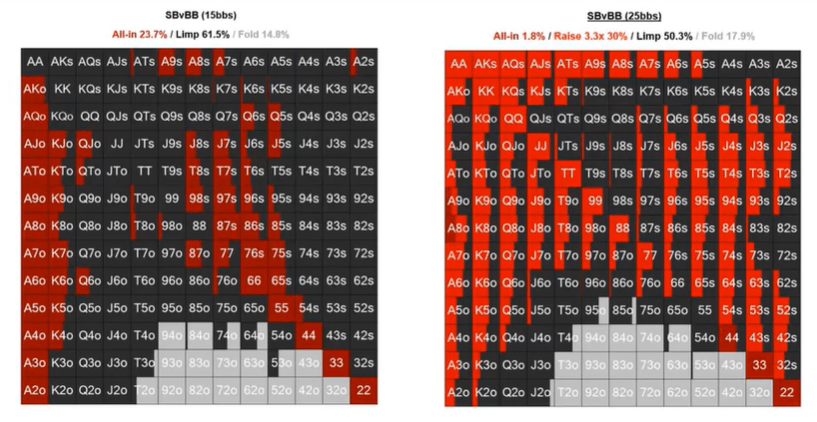
Notice that the 15 big blind stack moves all-in with 23.7% of their range while with 25 big blinds the small blind almost never shoves. Additionally, notice how many hands “mix”, playing one way some percentage of the time and playing another at a different frequency.
It is practically impossible for a human being to perfectly implement the right percentages for every hand, which is why I recommend my students simplify their use of charts.
Ace-nine offsuit, according to the 25 big blinds effective SBvsBB chart, should move all-in roughly 10% of the time, raise 3.3x 25% of the time, and limp 65% of the time. Instead of trying to properly hit these percentages, take the action that is done the majority of the time, and simply make that action every time.
You will make your life a lot easier limping ace-nine offsuit every time from the small blind rather than trying to play to the proper GTO frequencies, and you will make the same amount of money.

Are you a pro at playing draws? Take the quiz that tells you!
Strategy Differences Between Playing 15 and 25 Big Blinds Deep From The Small Blind
Playing 25 big blinds effective when first to act from the small blind, you raise with your best hands and A-X hands that do not flop well. You also raise 3.3x with junky, suited hands as well as some junky off-suit hands that don’t mind inducing folds.
With 25 big blinds effective from the small blind, your limping range should consist of hands that flop reasonably well or barely have enough equity to call for an additional blind.
Looking for the strategy differences in short stack play between a 15 big blind effective stack and a 25 big blind effective stack, one of the most prominent is the fact that a 15 big blind stack has an open shoving range while a 25 big blind stack does not. Another critical difference is that a 25 big blind stack raises with their best, premium hands while a 15 big blind stack elects to slowplay/limp.
Being willing to build a limping range 15 big blinds effective from the small blind allows you to add more hands to your playable range. Only going all-in or folding with 15 big blinds effective limits you to two options, by utilizing a limping strategy you essentially get to play with over 80% of hands in your range and can do more than just shove or fold.
When You Limp From The Small Blind (15 BB) And The Big Blind Shoves
The following charts demonstrate the optimal strategy for the small blind when they limp with 15 big blinds effective and are shoved on by the big blind.
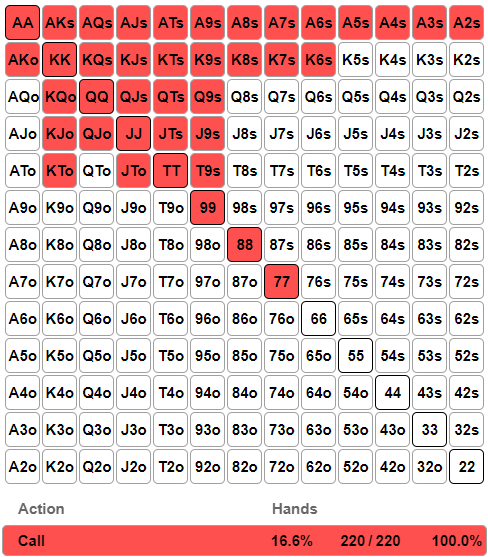
You can see what hands in the small blind’s 15 big blind limping range call off when the big blind elects to shove.
But what if the big blind raises instead of shoving? Below is the optimal strategy for the small blind (15 big blinds effective) when they limp and are raised by the big blind.
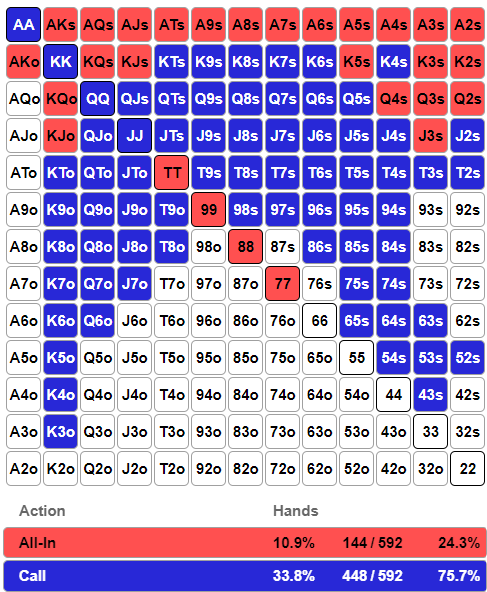
While the small blind rips it all-in with 12% of the hands in their calling range, they call with 49% of hands which includes pocket jacks and better. The strategy behind the small blind continuing to slowplay their premium pocket pairs is not only does it keep your opponent in the hand to get more money in, but it also balances your calling range.
By limping and calling with aces, the small blind puts the big blind in a way worse spot as they have a wide variety of hands in their range.
When You Limp From The Small Blind (25 BB) And The Big Blind Shoves
When the small blind limps with 25 big blinds and faces an all-in from the big blind, how does their strategy differ from when they have 15 big blinds? Examine the following chart:

Notice some hands are “missing” from the chart, that is because the small blind raises those hands when they are 25 big blinds effective.
While calling off with certain hands within the shown chart may make sense, other hands like jack-ten offsuit may make a player more hesitant. Remember: every chart in this article assumes that the opponent is playing a GTO strategy.
Always be adjusting to what your opponents do, if you are facing a tight nit you know is only shoving pocket queens and better, it is okay to fold jack-ten offsuit in this spot.
When You Limp From The Small Blind (25 BB) And The Big Blind Raises
Now let’s consider the proper strategy for the small blind when they face a raise rather than a shove from the big blind.
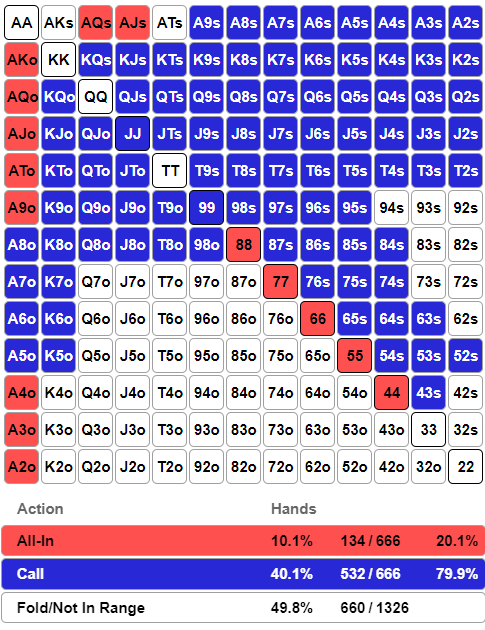
The 11% of shoving hands within the small blind’s range consists of blocker hands and medium pairs, with the remaining hands in the playable range calling.
Although a lot of poker players fail to do this, if you limp with a hand like queen-eight offsuit and the big blind raises, you are supposed to call.
Remember: by limping from the small blind, you get to play more hands in a variety of different ways. Many players fold way too much from the blinds, do not be afraid to battle and call with a wide range when you limp from the small blind.
When Folded To On The Button With A Short Stack
Instead of being folded to in the blinds, let’s say you are folded to on the button with 15-25 big blinds effective. The charts below demonstrate the proper strategy for both stack sizes:

Although there may be some charts recommending you limp with some hands when folded to on the button, my goal is to teach you easy, implementable strategies. Instead of maintaining a limping range when it folds to you on the button, stick with a raise or fold strategy to make your life easier.
The biggest difference playing with 15 big blinds as opposed to 25 is that a 15 big blind stack has an open shoving range, while a 25 big blind stack has no shoving range. When the button raises or moves all-in, what is the optimal strategy for the big blind?
Big Blind Versus Button Raise
Assuming the player on the button raises while playing a GTO strategy, below is the optimal strategy for the big blind when they have 15 and 25 big blinds effective:
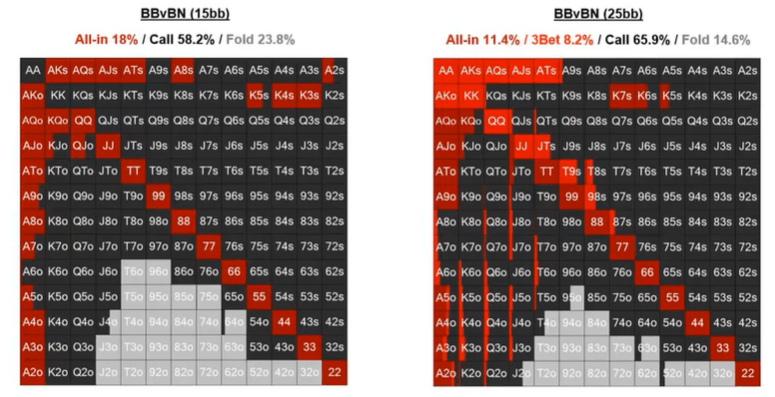
15 Big Blinds Effective
With 15 big blinds effective facing a raise from the button, the big blind flats with ace and kings but shoves with any other pocket pair. The big blind also shoves with the majority of their A-X offsuit combos (minus A-6 offsuit), as well as an assortment of A-X suited and K-X suited combos. While the big blind (15 big blinds effective) does have a shoving range, 58% of their entire range is made up of calling hands.
25 Big Blinds Effective
Facing a button raise, with 25 big blinds effective from the big blind you do have a three-betting range, although it is small (8%). Three-bet with your best A-X suited hands, premium pairs, and good suited connectors, if the button moves all-in you must call off with all of these hands.
As opposed to 15 big blinds effective, your calling range is even wider when 25 big blinds deep as you add more junky hands to it. By having a proper calling range, you set yourself up to play with a better postflop strategy.
Although your calling range widens, your shoving range decreases, consisting of offsuit A-X hands, some suited K-X hands, and medium/low pocket pairs.
When Folded To In The Lojack (UTG 6-Handed)
When it folds to you in the lojack (or if you are UTG 6-handed), the following charts show the optimal strategy when playing 15 and 25 big blinds deep:

While these two ranges do not differ greatly, with 25 big blinds effective naturally you get to play with a bit wider range as opposed to 15 big blinds effective (25% and 20% respectively).
Even though you are in earlier position, you still maintain an open shoving range 15 big blinds effective from the lojack. With 15 big blinds effective, your open shoving range from the lojack consists of strong A-X offsuit hands as well as suited high cards.
Solvers really don’t like small pairs when playing shallow stacked, as small pocket pairs lack post-flop playability regardless of stack size.
Big Blind Versus Lojack Raise
Facing a lojack raise from the big blind, here is the optimal strategy when playing with a 15 big blind effective stack and a 25 big blind effective stack:

While the big blind maintains an all-in range playing with both stack sizes, naturally the shoving range 15 big blinds effective is wider than with 25 big blinds effective. Although the shoving ranges differ, both 15 and 25 big blind stacks maintain a 66% calling range when facing a lojack raise.
A lot of people get down to 25 big blinds and start utilizing an “all-in or fold” strategy, and by doing so they are not playing profitably. With 25 big blinds, you have enough chips to develop a three-betting range when facing a raise from the lojack.
With 25 big blinds effective the big blinds three-betting range is very polarized, consisting of their best premium hands as well as some junky blocker hands. While it may make you nervous three-betting a raise holding K-4 offsuit, it is the optimal strategy when playing GTO.
Short Stacked Hijack Facing A Lojack Raise
The last set of charts I will be covering pertain to facing a lojack raise from the hijack with both 15 and 25 big blinds effective:

Playing from an earlier position, the 15 big blind strategy from the hijack is much more linear, playing a strict “all-in or fold” strategy. With 25 big blinds effective, the hijack gets to implement a three-betting range consisting of high A-X offsuit hands as bluffs as well as some A-X suited hands.
While some hands like pocket nines and pocket eights are recommended by the chart to mix calling and three-betting, you can make your life easier by just calling with these hands. Even though hands mix more often deeper stacked, you can make implementing GTO strategies easier by simply taking what a particular hand does the majority of the time, and making that play every time you are dealt that hand. You might leave some money on the table by not mixing, but you will make your life a lot easier.
Examining the hijack’s calling range 25 big blinds effective, although it is only 7% of the total playable range, it still may seem somewhat wide. Often optimal calling strategies are looser than players think they should be.
Flatting is not so bad when there are antes in play, as antes add more dead money to the pot. By flatting with hands like K-10 suited but also pocket aces, the hijack can protect their flatting range and can potentially get it in good when an opponent tries to squeeze.
Conclusion
Whether you play online or live poker, implementing GTO strategies can seem like a daunting task if you are not familiar with them. Starting with chart study can greatly benefit a player looking to add GTO concepts to their short stack strategy. As you begin utilizing GTO short stack strategies, avoid overfocusing on “mixing” and playing certain hands at the proper percentages. If a hand three-bets 60% of the time, simply three-bet with it every time. Knowing GTO strategies, but also knowing how to easily apply them to your game, with take you far at the poker table.

